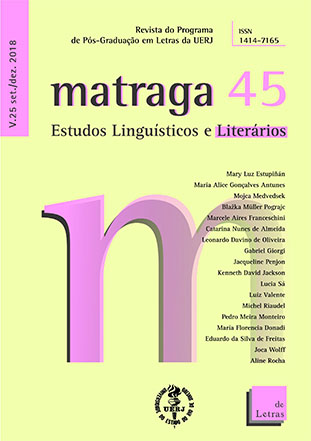‘Un suelo que no deja de moverse:’ non-human temporalities in Nuno Ramos
DOI:
https://doi.org/10.12957/matraga.2018.36772Keywords:
Nuno Ramos, temporality, bios.Abstract
Perhaps some of the most significant investigations in contemporary literature and art from Brazil revolve around the question of temporality, the threshold between the living and the dead and the ways in which conflicting temporalities and anachronism articulate a critique of the present. In this context, Nuno Ramos’ installations and writings, working on the unstable terrain between the living and the dead, the organic and the inorganic, the fossilized and the spectral, represent a decisive intervention. In Ramos’ works memory is never entirely human; it is irreducible to the domain of subjectivity nor to the shared narratives of the collective. From books such as Cujo or Junco to the the fossilized matter present in many of his works, the relationship between life and death is both political, technological and non-anthropomorphic — it is, in other words, biopolitical. This paper analyzes the ways in which the configuration of such critical perspective in Nuno Ramos’ work interrogates and reformulates the ways in which temporality and the political interface there where the very notion of life — the bios that articulates the biopolitical— is at stake.
---
Original in Spanish.
Downloads
Downloads
Published
How to Cite
Issue
Section
License
Authorization
Matraga – Scientific Journal of the Post-graduate Program in Arts and Humanities of UERJ is authorized to publish the article submitted here, if it is accepted for online publication. It is attested that the contribution is original, that it is not being submitted to another publisher for publication, and that this statement is the expression of truth.
The works published in Matraga's virtual space – Scientific Journal of the Post-graduate Program in Arts and Humanities of UERJ will be automatically transferred, and your copyright is reserved to Matraga. Its reproduction, in whole or in part, is conditional on the citation of the authors and the data of the publication.

Matraga uses license Creative Commons - Attribution-Non-Commercial 4.0 International.





